


MICHELANGELO 1475 -
(E4, E5, R3, H7, H8, E6, M1, L1)
xxxxxAs we have 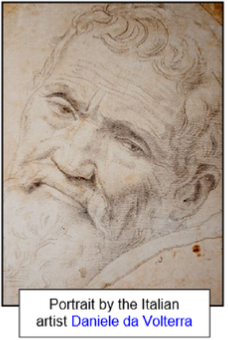 seen (1504 H7), Michelangelo was apprenticed to Domenico Ghirlandajo at the age of 13 and worked for a time in the household of Lorenzo the Magnificent. With the expulsion of the Medici family from Florence in 1494, he also left the city and, after spending two years in Bologna, settled in Rome. It was here that he produced two of his many masterpieces, the larger-
seen (1504 H7), Michelangelo was apprenticed to Domenico Ghirlandajo at the age of 13 and worked for a time in the household of Lorenzo the Magnificent. With the expulsion of the Medici family from Florence in 1494, he also left the city and, after spending two years in Bologna, settled in Rome. It was here that he produced two of his many masterpieces, the larger-
xxxxxIt was after his return to Florence in 1501 that he undertook his colossal marble figure of the young biblical David, a work that became a symbol of his native city and an outstanding example of Renaissance art. Also to this period belongs the Holy Family, and preparatory drawings for a vast battle scene, planned for the new council hall but, like so many of Michelangelo’s works, never completed.
xxxxxIn 1505 he was summoned to Rome to take part in a vast undertaking, the magnificent tomb for Pope Julius II. Its completion, however, was long delayed, partly because in 1508 Michelangelo began work on one of his most ambitious projects, the painting of the barrel-
xxxxxThe story goes that, 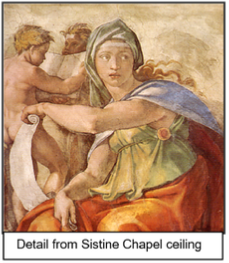 out of jealousy, the architect Bramante was anxious that Michelangelo should be given this commission, convinced that he would fail in the attempt. The exact opposite was the case. Working with some assistance, he finished the work in an amazingly short time -
out of jealousy, the architect Bramante was anxious that Michelangelo should be given this commission, convinced that he would fail in the attempt. The exact opposite was the case. Working with some assistance, he finished the work in an amazingly short time -
xxxxxHe painted the ceiling -
xxxxxThe work once finished, Michelangelo, then aged 37, returned to his beloved sculpture. He continued work on his impressive Moses, the central figure for the Julius Tomb -
xxxxxIn 1534 he returned to the Sistine Chapel, 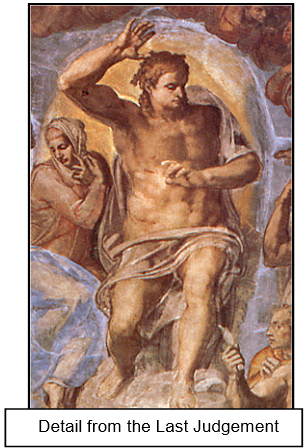 charged by Paul III with the task of painting the altar wall, previously decorated by Perugino. Here, in the space of six years, he completed his magnificent Last Judgement, a gigantic, powerful, and alarming scene which, by its vision of frightening retribution, surely shows Dante’s influence upon the artist. The largest fresco of the Renaissance, it shows Christ in the centre meting out justice (illustrated), and the damned writhing grotesquely as they descend into hell.
charged by Paul III with the task of painting the altar wall, previously decorated by Perugino. Here, in the space of six years, he completed his magnificent Last Judgement, a gigantic, powerful, and alarming scene which, by its vision of frightening retribution, surely shows Dante’s influence upon the artist. The largest fresco of the Renaissance, it shows Christ in the centre meting out justice (illustrated), and the damned writhing grotesquely as they descend into hell.
xxxxxIn was during this period, in 1536, that he first met Vittoria Colonna, a devout woman poetess. He deeply admired her simple faith and during their spiritual friendship they exchanged many letters and poems. She died in 1547.
xxxxxMichelangelo was also a talented architect. As early as 1519 he drew up plans for the facade of the church of San Lorenzo in Florence, and he also designed the elegant entrance hall for the adjoining Laurentian Library. At one stage, too, during the war against the Medici, beginning in 1527, he supervised the city’s fortifications. In Rome, his skill as an architect was not employed until later in life. In 1538 he completely redesigned the Campidoglio, the civic centre, but it was at St. Peter’s Basilica, where he was appointed chief architect in 1546, that he made his greatest contribution to the city.
xxxxxApart from Michelangelo, the 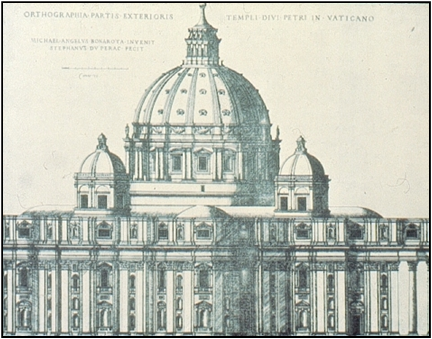 major architects who played a prominent part in the construction of the new St. Peter’s Basilica were the Italians Donato Bramante, Sanzio Raphael, and Carlo Maderno. As we have seen, it was in 1506 (H7) that Bramante, appointed by Pope Julius II, began work on the rebuilding of the Basilica, the famous church within the Vatican City, built over the tomb of Saint Peter. He envisaged an impressive square building in the shape of an equally-
major architects who played a prominent part in the construction of the new St. Peter’s Basilica were the Italians Donato Bramante, Sanzio Raphael, and Carlo Maderno. As we have seen, it was in 1506 (H7) that Bramante, appointed by Pope Julius II, began work on the rebuilding of the Basilica, the famous church within the Vatican City, built over the tomb of Saint Peter. He envisaged an impressive square building in the shape of an equally-
xxxxxAs noted above, Michelangelo was made chief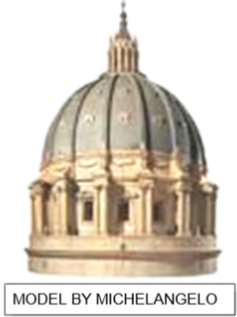 architect in 1546. Appointed by Pope Paul III, he took up the appointment with a great deal of reluctance but, in fact, his contribution -
architect in 1546. Appointed by Pope Paul III, he took up the appointment with a great deal of reluctance but, in fact, his contribution -
xxxxxAs we shall see (1633 C1), it was the Italian artist Lorenzo Bernini who designed and built the immense and imposing piazza in front of the basilica. Completed in 1667, its vast oval shape is elegantly contained by two gigantic arcades of Tuscan columns, sweeping in a semi-
xxxxxIncidentally, towards the end of the 20th century, both of Michelangelo’s works in the Sistine Chapel were cleaned and restored. The removal of centuries’ of dirt, smoke and varnish has virtually revealed their original colours. But this “clean-
xxxxxMichelangelo’s immense talent as an artist -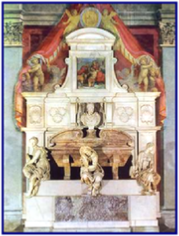 be it as a painter, sculptor or architect -
be it as a painter, sculptor or architect -
THE CEILING OF THE SISTINE CHAPEL -
xxxxxAs we have seen (1504 H7), Michelangelo worked for the Medici in Florence and then settled in Rome, where he executed his exquisite Pietà. He returned to Florence in 1501 and then undertook his fine marble figure of the biblical David. In 1505 he was summoned to Rome to work on the magnificent tomb of Pope Julius II, but three years later he began his breathtaking work on the ceiling of the Sistine Chapel, providing a vast panorama of the Book of Genesis, not finished until 1512. After completing the Julian tomb and producing his set of nude figures depicting Day and Night, Morning and Evening, he returned to the Sistine Chapel and spent six years on his Last Judgement, a gigantic, alarming work which clearly showed the influence of Dante. As an architect he designed buildings in Florence and Rome, and played a major part in the planning of the dome for St. Peter's Basilica. A man of immense talent, Michelangelo dominated the High Renaissance as a painter, sculptor and architect.
Including:
St. Peter’s Basilica, Rome,
Sebastiano del Piombo,
and Andrea del Sarto

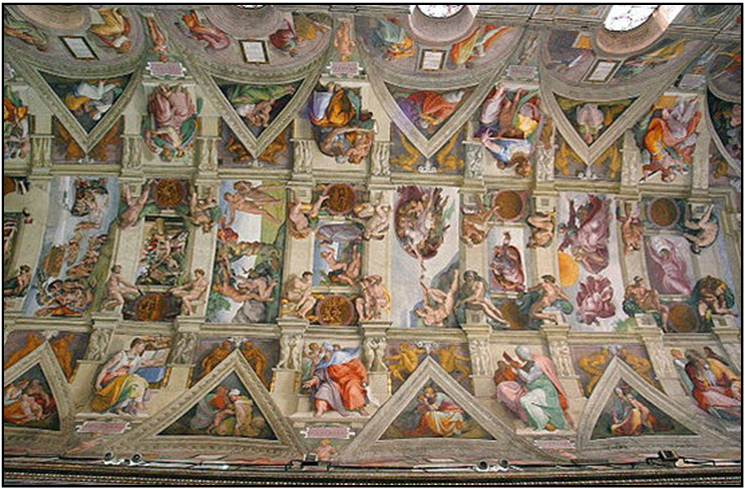
xxxxxA Venetian artist who was 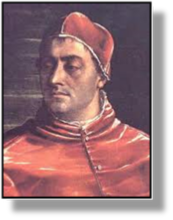 greatly encouraged and assisted by Michelangelo was Sebastiano del Piombo (c1485-
greatly encouraged and assisted by Michelangelo was Sebastiano del Piombo (c1485-
xxxxxA Florentine painter of this period who 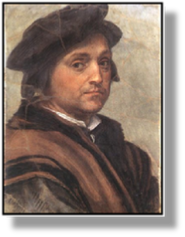 deserves mention is Andrea del Sarto (1486-
deserves mention is Andrea del Sarto (1486-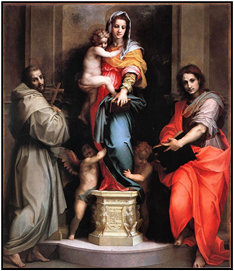 rich colour, and for the subtle use of light and shade (known as sfumato), he was soon in much demand. His reputation was further enhanced by his series of grey monochrome frescoes on the life of John the Baptist in the Chiostro dello Scalzo, but his masterpiece is generally considered to be his Madonna del Sacco, painted in the cloister of the Servite church in 1525. Among other religious works well worthy of note are the Madonna of the Harpies, now in the Uffizi Gallery, Florence (
rich colour, and for the subtle use of light and shade (known as sfumato), he was soon in much demand. His reputation was further enhanced by his series of grey monochrome frescoes on the life of John the Baptist in the Chiostro dello Scalzo, but his masterpiece is generally considered to be his Madonna del Sacco, painted in the cloister of the Servite church in 1525. Among other religious works well worthy of note are the Madonna of the Harpies, now in the Uffizi Gallery, Florence (
xxxxxIncidentally, “harpies” refers to the monster-



Acknowledgements
Portrait: by the Italian artist Daniele de Volterra (c1509-
H8-